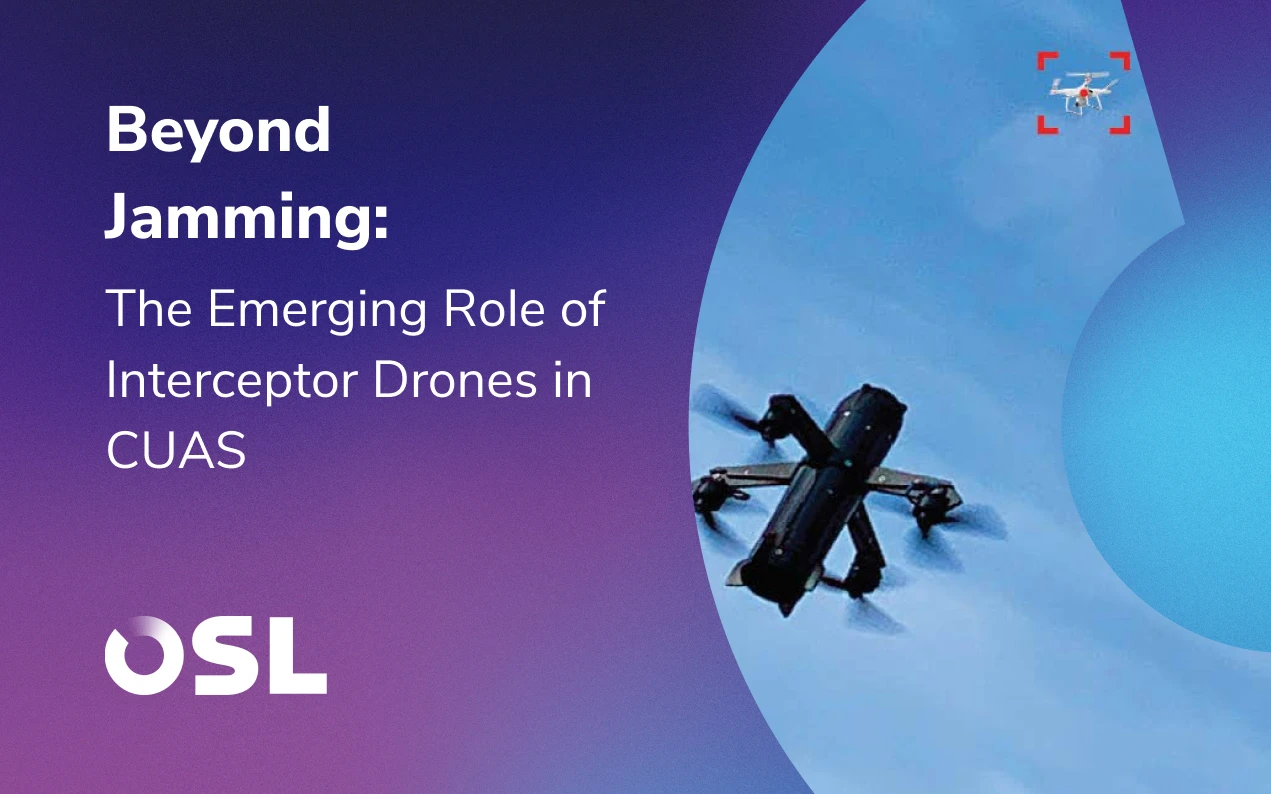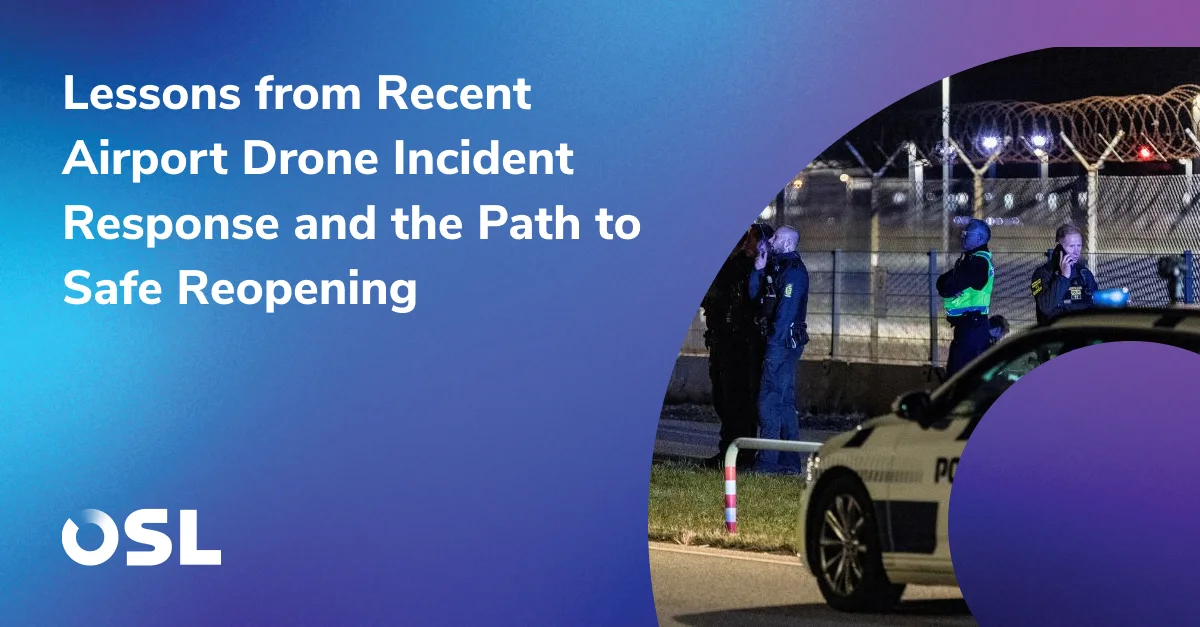Beyond Jamming: The Emerging Role of Interceptor Drones in CUAS


Across airports, refineries, and defence sites, the next phase of airspace protection is taking shape. Field experience is showing where traditional tools reach their limits and where greater certainty is required.
Electronic and cyber-based countermeasures, such as RF jamming or spoofing, remain essential. Yet they rely on conditions that cannot always guarantee a visible control link, legal authorisation to interfere with it, and a clear line of sight. As drone technology becomes more autonomous, these constraints grow.
In this changing environment, interceptor drones and drone-borne effectors are emerging as decisive assets. They assure physical interception when other methods fall short, offering a controlled and proportionate means of protection across both military and civilian operations.
When Certainty Matters
Non-kinetic options are often preferred for their reversibility, but they may not deliver the immediacy required when a drone poses a direct risk to people or critical assets. In such cases, operators now turn to interceptor drones. These are agile platforms designed to physically capture or neutralise hostile drones within seconds.
This evolution builds on what was once described as kinetic CUAS, but the emphasis today is precision and accountability. Interceptor drones, whether equipped with nets, directed intercept mechanisms, or other effectors, offer rapid, targeted responses that minimise risk to surrounding critical infrastructure.
A recent incident in Poland illustrated this need for certainty. When multiple drones crossed Polish airspace in September 2025, NATO-aligned forces engaged physically to prevent further escalation. The episode underscored a wider truth: in contested environments, responsible drone neutralisation remains the only viable safeguard against uncertain or hostile intent.
Interceptor vs Non-Kinetic Counter-Drone Solutions
The debate between kinetic and non-kinetic tools is giving way to a more mature view, one based on context rather than category. Non-kinetic solutions provide early, reversible intervention, suitable for situations where disruption alone is sufficient. Interceptor drones complement this by offering finality when an immediate and reliable outcome is required.
Operators no longer ask which method to use; instead, they ensure operational authorisation for kinetic and interceptor measures. Integrating both within a single operational framework allows for escalation through defined stages, guided by structured authorisation and informed by data-driven command systems.
The Importance of Precision and Control
Physical interception requires more than speed. Every engagement must be authorised, proportionate, and safe. This is where AI-powered command and control (C2) platforms transform decision-making.
By fusing radar, RF, optical, and acoustic data into a single operational picture, AI systems calculate safe engagement zones before any action is taken. They model debris trajectories, collateral risks, and likely outcomes, ensuring each decision is based on evidence, not impulse.
This level of intelligence-led control allows interceptor drones to operate within strict safety envelopes, maintaining trust between operational teams and regulators. It's a principle already visible across complex, high-risk deployments, from major airports to Defence environments.
Drone-Borne Effectors and Mobile Response
Alongside interceptor drones, drone-borne effectors are expanding the scope of what a CUAS solution can achieve. Modular "drone-in-a-box" systems enable rapid deployment and flexible payloads, allowing interceptors to pursue threats beyond the range of fixed sensors or ground-based effectors.
This mobility offers unique advantages in environments such as ports, oil and gas facilities, or extended perimeter sites where drone threats can emerge unpredictably.
When supported by AI analytics and human oversight, these autonomous systems can act quickly and effectively. They stay accountable by combining automation with human judgment in real time.
Regulation and Authorisation
As physical interception technologies mature, regulation must keep pace. Without clear rules, even the most capable interceptor drone can create hesitation in moments that demand confidence.
Authorities across NATO and Europe are already defining frameworks that govern who may authorise an interception, under what conditions, and with which systems. Organisations such as EUROCAE Working Group 115 and NATO's Defence Innovation Accelerator are contributing to international counter-UAS regulation that prioritises interoperability and accountability.
Progress is visible, but uneven. National and sectoral differences still create uncertainty, and operational authorisation for interceptor or kinetic measures remains inconsistent. Establishing a common language and procedures will be critical to ensuring operators can act responsibly under pressure.
Human Judgement and Decision Support
Despite advances in automation, human judgment remains the foundation of safe CUAS operations. AI systems provide the intelligence, but people provide the discipline.
Decision-support tools reduce cognitive load by presenting only what matters most: the situational picture, risk level, and authorised responses. This balance between automation and oversight ensures that every action, whether non-kinetic or interceptor-based, aligns with legal and ethical expectations.
Acting Responsibly Under Pressure
The growing use of interceptor drones marks a natural progression in counter-drone strategy. Yet capability must always be matched with responsibility. Without clear authorisation, training, and rules of engagement, even advanced systems risk misjudgement.
Responsible deployment depends on trusted data, defined authority, and confidence in both technology and people. Interceptor drones and drone-borne effectors provide reliable results. However, this is only true when they are used within structured, lawful frameworks that safeguard airspace and ensure accountability.
Conclusion
The rise of interceptor drones represents a turning point for CUAS operations. They extend the spectrum of available responses while reinforcing the need for precision, governance, and trust. Kinetic and non-kinetic measures now coexist as complementary layers of a mature defence strategy.
They are supported by AI-powered C2, clear authorisation, and human oversight, enabling operators to act confidently and decisively. This ensures that every decision made under pressure serves one goal: the safe and lawful protection of critical airspace.
FAQs
1. What are interceptor drones?
Interceptor drones are unmanned aircraft designed to stop or destroy hostile drones when electronic or cyber methods fail. They provide fast, targeted, and controllable responses across both civilian and defence operations.
2. How do drone-borne effectors work?
Drone-borne effectors are UAVs equipped with modular payloads that allow them to capture or disable targets. Often based on "drone-in-a-box" platforms, they can deploy automatically and pursue threats. Plus, they can operate within defined safety limits under human supervision.
3. How do interceptor and non-kinetic solutions differ?
Non-kinetic options such as RF jamming provide early-stage, reversible intervention. Interceptor drones, formerly grouped under kinetic CUAS, deliver finality when certainty is essential, particularly against autonomous or high-risk threats.
4. Why is AI-powered command and control important?
AI-driven C2 systems integrate multi-sensor data, calculate engagement safety, and show operators pre-authorised options. This is especially important for managing small drones and evolving threats, ensuring every action is safe and accountable while drones are flying in sensitive areas.
5. What authorisation is required for physical interception?
Regulations are changing as drone technology evolves. Authorities are defining clear conditions for interceptor deployment, often requiring coordination with defence, law enforcement, or aviation regulators. This ensures that physical interception of flying drones, including small drones, is lawful and proportionate.
6. What is an autonomous counter-drone response?
An autonomous counter-drone response is when drones or AI systems detect and stop hostile drones on their own. Humans still supervise to ensure actions are safe and responsible.
7. How does decision support for security operations help CUAS teams?
Decision support for security operations uses AI to provide operators with the information they need. It shows risks, situational data, and allowed actions so teams can act quickly, safely, and legally.
Editor's Pick
Secure your airspace with adaptive drone defence solutions
Ensure operational safety with multi-layered solutions designed to counter unauthorised drones and protect complex environments.




